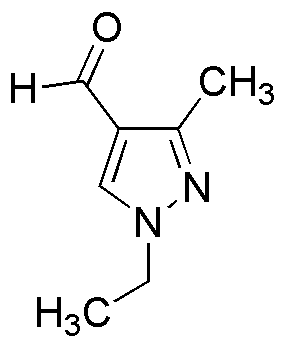1-Ethyl-3-methyl-1H-pyrazole-4-carbaldehyde is widely utilized in research focused on:
- Pharmaceutical Development: This compound serves as a key intermediate in the synthesis of various pharmaceuticals, particularly in the development of anti-inflammatory and analgesic drugs, enhancing therapeutic efficacy.
- Agricultural Chemistry: It is used in the formulation of agrochemicals, including pesticides and herbicides, contributing to improved crop protection and yield, which is vital for sustainable agriculture.
- Material Science: The compound is explored for its potential in creating novel materials, including polymers and coatings, offering enhanced properties like durability and resistance to environmental factors.
- Analytical Chemistry: It acts as a reagent in analytical methods for detecting and quantifying other chemical substances, providing reliable results in quality control processes across various industries.
- Research in Organic Synthesis: This chemical is utilized in academic and industrial laboratories for synthesizing complex organic molecules, facilitating advancements in organic chemistry and related fields.
General Information
Properties
Safety and Regulations
Applications
1-Ethyl-3-methyl-1H-pyrazole-4-carbaldehyde is widely utilized in research focused on:
- Pharmaceutical Development: This compound serves as a key intermediate in the synthesis of various pharmaceuticals, particularly in the development of anti-inflammatory and analgesic drugs, enhancing therapeutic efficacy.
- Agricultural Chemistry: It is used in the formulation of agrochemicals, including pesticides and herbicides, contributing to improved crop protection and yield, which is vital for sustainable agriculture.
- Material Science: The compound is explored for its potential in creating novel materials, including polymers and coatings, offering enhanced properties like durability and resistance to environmental factors.
- Analytical Chemistry: It acts as a reagent in analytical methods for detecting and quantifying other chemical substances, providing reliable results in quality control processes across various industries.
- Research in Organic Synthesis: This chemical is utilized in academic and industrial laboratories for synthesizing complex organic molecules, facilitating advancements in organic chemistry and related fields.
Documents
Safety Data Sheets (SDS)
The SDS provides comprehensive safety information on handling, storage, and disposal of the product.
Product Specification (PS)
The PS provides a comprehensive breakdown of the product’s properties, including chemical composition, physical state, purity, and storage requirements. It also details acceptable quality ranges and the product's intended applications.
Certificates of Analysis (COA)
Search for Certificates of Analysis (COA) by entering the products Lot Number. Lot and Batch Numbers can be found on a product’s label following the words ‘Lot’ or ‘Batch’.
*Catalog Number
*Lot Number
Certificates Of Origin (COO)
This COO confirms the country where the product was manufactured, and also details the materials and components used in it and whether it is derived from natural, synthetic, or other specific sources. This certificate may be required for customs, trade, and regulatory compliance.
*Catalog Number
*Lot Number
Safety Data Sheets (SDS)
The SDS provides comprehensive safety information on handling, storage, and disposal of the product.
DownloadProduct Specification (PS)
The PS provides a comprehensive breakdown of the product’s properties, including chemical composition, physical state, purity, and storage requirements. It also details acceptable quality ranges and the product's intended applications.
DownloadCertificates of Analysis (COA)
Search for Certificates of Analysis (COA) by entering the products Lot Number. Lot and Batch Numbers can be found on a product’s label following the words ‘Lot’ or ‘Batch’.
*Catalog Number
*Lot Number
Certificates Of Origin (COO)
This COO confirms the country where the product was manufactured, and also details the materials and components used in it and whether it is derived from natural, synthetic, or other specific sources. This certificate may be required for customs, trade, and regulatory compliance.


